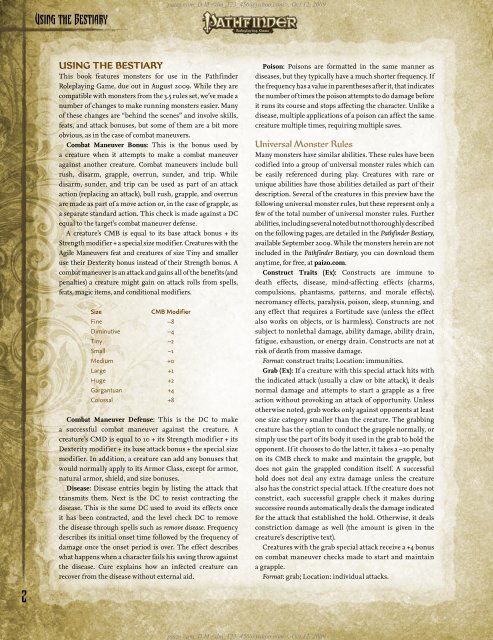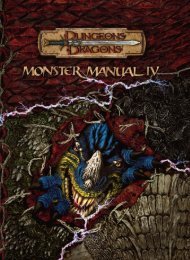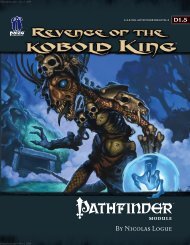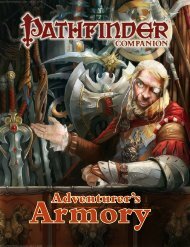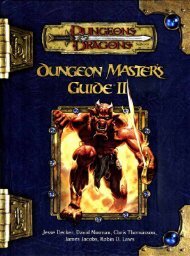Bonus Bestiary.pdf
Bonus Bestiary.pdf
Bonus Bestiary.pdf
- No tags were found...
You also want an ePaper? Increase the reach of your titles
YUMPU automatically turns print PDFs into web optimized ePapers that Google loves.
450921<br />
643286<br />
643286<br />
450921<br />
450921<br />
643286<br />
Using the <strong>Bestiary</strong><br />
paizo.com, D M , Oct 12, 2009<br />
USING THE <strong>Bestiary</strong><br />
This book features monsters for use in the Pathfinder<br />
Roleplaying Game, due out in August 2009. While they are<br />
compatible with monsters from the 3.5 rules set, we’ve made a<br />
number of changes to make running monsters easier. Many<br />
of these changes are “behind the scenes” and involve skills,<br />
feats, and attack bonuses, but some of them are a bit more<br />
obvious, as in the case of combat maneuvers.<br />
Combat Maneuver <strong>Bonus</strong>: This is the bonus used by<br />
a creature when it attempts to make a combat maneuver<br />
against another creature. Combat maneuvers include bull<br />
rush, disarm, grapple, overrun, sunder, and trip. While<br />
disarm, sunder, and trip can be used as part of an attack<br />
action (replacing an attack), bull rush, grapple, and overrun<br />
are made as part of a move action or, in the case of grapple, as<br />
a separate standard action. This check is made against a DC<br />
equal to the target’s combat maneuver defense.<br />
A creature’s CMB is equal to its base attack bonus + its<br />
Strength modifier + a special size modifier. Creatures with the<br />
Agile Maneuvers feat and creatures of size Tiny and smaller<br />
use their Dexterity bonus instead of their Strength bonus. A<br />
combat maneuver is an attack and gains all of the benefits (and<br />
penalties) a creature might gain on attack rolls from spells,<br />
feats, magic items, and conditional modifiers.<br />
Size<br />
CMB Modifier<br />
Fine –8<br />
Diminutive –4<br />
Tiny –2<br />
Small –1<br />
Medium +0<br />
Large +1<br />
Huge +2<br />
Gargantuan +4<br />
Colossal +8<br />
Combat Maneuver Defense: This is the DC to make<br />
a successful combat maneuver against the creature. A<br />
creature’s CMD is equal to 10 + its Strength modifier + its<br />
Dexterity modifier + its base attack bonus + the special size<br />
modifier. In addition, a creature can add any bonuses that<br />
would normally apply to its Armor Class, except for armor,<br />
natural armor, shield, and size bonuses.<br />
Disease: Disease entries begin by listing the attack that<br />
transmits them. Next is the DC to resist contracting the<br />
disease. This is the same DC used to avoid its effects once<br />
it has been contracted, and the level check DC to remove<br />
the disease through spells such as remove disease. Frequency<br />
describes its initial onset time followed by the frequency of<br />
damage once the onset period is over. The effect describes<br />
what happens when a character fails his saving throw against<br />
the disease. Cure explains how an infected creature can<br />
recover from the disease without external aid.<br />
Poison: Poisons are formatted in the same manner as<br />
diseases, but they typically have a much shorter frequency. If<br />
the frequency has a value in parentheses after it, that indicates<br />
the number of times the poison attempts to do damage before<br />
it runs its course and stops affecting the character. Unlike a<br />
disease, multiple applications of a poison can affect the same<br />
creature multiple times, requiring multiple saves.<br />
Universal Monster Rules<br />
Many monsters have similar abilities. These rules have been<br />
codified into a group of universal monster rules which can<br />
be easily referenced during play. Creatures with rare or<br />
unique abilities have those abilities detailed as part of their<br />
description. Several of the creatures in this preview have the<br />
following universal monster rules, but these represent only a<br />
few of the total number of universal monster rules. Further<br />
abilities, including several noted but not thoroughly described<br />
on the following pages, are detailed in the Pathfinder <strong>Bestiary</strong>,<br />
available September 2009. While the monsters herein are not<br />
included in the Pathfinder <strong>Bestiary</strong>, you can download them<br />
anytime, for free, at paizo.com.<br />
Construct Traits (Ex): Constructs are immune to<br />
death effects, disease, mind-affecting effects (charms,<br />
compulsions, phantasms, patterns, and morale effects),<br />
necromancy effects, paralysis, poison, sleep, stunning, and<br />
any effect that requires a Fortitude save (unless the effect<br />
also works on objects, or is harmless). Constructs are not<br />
subject to nonlethal damage, ability damage, ability drain,<br />
fatigue, exhaustion, or energy drain. Constructs are not at<br />
risk of death from massive damage.<br />
Format: construct traits; Location: immunities.<br />
Grab (Ex): If a creature with this special attack hits with<br />
the indicated attack (usually a claw or bite attack), it deals<br />
normal damage and attempts to start a grapple as a free<br />
action without provoking an attack of opportunity. Unless<br />
otherwise noted, grab works only against opponents at least<br />
one size category smaller than the creature. The grabbing<br />
creature has the option to conduct the grapple normally, or<br />
simply use the part of its body it used in the grab to hold the<br />
opponent. If it chooses to do the latter, it takes a –20 penalty<br />
on its CMB check to make and maintain the grapple, but<br />
does not gain the grappled condition itself. A successful<br />
hold does not deal any extra damage unless the creature<br />
also has the constrict special attack. If the creature does not<br />
constrict, each successful grapple check it makes during<br />
successive rounds automatically deals the damage indicated<br />
for the attack that established the hold. Otherwise, it deals<br />
constriction damage as well (the amount is given in the<br />
creature’s descriptive text).<br />
Creatures with the grab special attack receive a +4 bonus<br />
on combat maneuver checks made to start and maintain<br />
a grapple.<br />
Format: grab; Location: individual attacks.<br />
2<br />
paizo.com, D M , Oct 12, 2009


